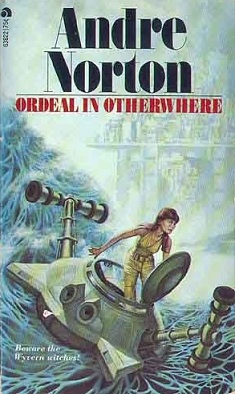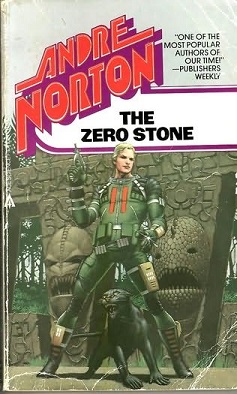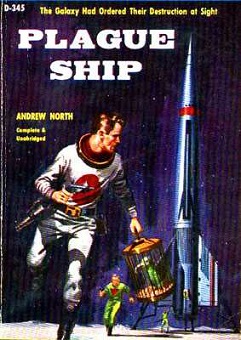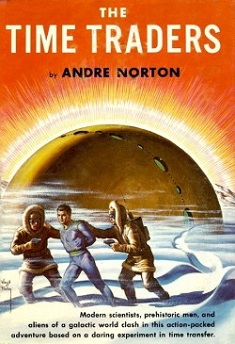
Ordeal in Otherwhere
Andre Norton
203 pages
published in 1964
As I said in my review of Andre Norton’s The Zero Stone, where I’d wondered about its lack of women, what was truly odd was that Ordeal in Otherwhere, published four years before it, had a female protagonist. Which I knew because I was already reading it when I wrote that review, as the second book in my Week of Norton. And whereas The Zero Stone contained no women, Ordeal in Otherwhere is one that easily passes the Bechdel test. Nevertheless, as we will see, it does share some of the same gender assumptions as that other book and indeed, most of Norton’s stories I’ve read so far. They’re a product of the time they were written in after all and so it’s not surprising they confirm to the gender roles of fifty years ago.
Nevertheless, this is a novel in which the standard Norton hero is a young woman rather than a young man, one just as inventive, smart and brave as her male counterparts. Charis Nordholm is a young woman left an orphan when her father died of the White Plague sweeping the new colony on Demeter. Ander Nordholm was the educational officer off the colony and had raised his daughter to be inquisitive and competent, something resented by the religious fanatics in the colony. So they sell her into slavery (have her sign a contract of indefinitive length) to a Free Trader, who in turn sells her on to another trader, who takes her to the planet Warlock. The trader needs her to establish trade with the native inhabitants of Warlock, a matriarchal society called Wyverns, the women of which have strange powers. These only talk to other women, hence the need for Charis, who herself hopes to find a way to contact the Survey station somewhere on Warlock to get herself feed from bondage. Of course, things don’t quite work out that simply…
Before long Charis is transported, kidnapped, lured (?) out of the trading post and into the wilds of Warlock, a restless power driving her on. She has to battle this force as well as the natural dangers of the wilderness, but soon gains an ally in the form of a small, furry, telepathic creature called Tsstu. It soon becomes clear to Charis that her half waking, half sleeping ordeals are a test, a test of her character and abilities, one she has passed as she finds herself with the Wyvern women in their citadel, learning to use the same dream powers they have. By concentrating on her guide, a small disc engraved with a spiral design that serves as a focus for her mind, she becomes able to transport herself to other places at will, as long as she can picture them.
Time passes as in a dream and Charis is content with it, until one day she notices a general sense of unease amongst the Wyverns. It prompts her to get back to the meadow where she first met Tsstu. There she finds evidence of violence and it becomes clear something had happened to the trader that had brought her to Warlock. On impulse she transports herself back to his trading post, only to find it destroyed, with a body lying in the ruins. Before she can look who it is though she’s intercepted by a member of the Survey post established on Warlock, who introduces himself as cadet Shann Lantee. Together they start to investigate what happened to the trading post and when they find a spear, of the type Wyvern men use amongst the rubble, Charis calls one of her friends amongst the Wyvern witches, who takes one look at the situation, banishes Shann and takes Charis back to the Citadel.
For the witches all this is a sign they need to purge their planet from all outsiders and force their men back into their service. Charis, meanwhile is desparate not just for her own safety but that of Shann as well and attempts to convince the witches to let her try another way. The reluctantly agree and set her another test, one she must escape before she can rescue Shann, find the people responsible for the attack and stop them from using the male Wyverns to gain the power of Warlock for themselves.
Charis is a capable, competent protagonist and she doesn’t fade when Shann comes in the story; Norton portrays them as equals each with their own strengths. As with all old timey science fiction authors, she packs a lot of plot into twohundred pages and it all moves at breakneck speed. Ordeal in Otherwhere is not as well written as The Zero Stone though, partially because so much happens. At first this looks like it’s going to be about how Charis wins her freedom, but then the focus switches to her exploration of Warlock under the tutelage of the witches, then it becomes a standard Norton adventure story in which Charis and Shann have to fight off the machinations of an evil trading company. It’s all a bit much, with some plot points dropped halfway through the story.
You do wonder how much of the problems on Warlock could’ve been prevented if the Survey Corps had sent some women to it, rather than men. But of course that’s impossible, as only men seem to work for the Corps… Granted, I am inferring this from the other Norton novels I’ve read, but that seems to be the prevailing attitude in her fifties and sixties works, an unthinking reflection of the gender mores of the time. You can see the same thing at work in the paternalistic attitude paid to the inhabitants of Warlock, who have to be prevented from exploitation by unscrupulous human traders whether they like it or not. The people in the Survey corps are idealistic and well intentioned, but there’s still a whiff of colonialism about their works.



